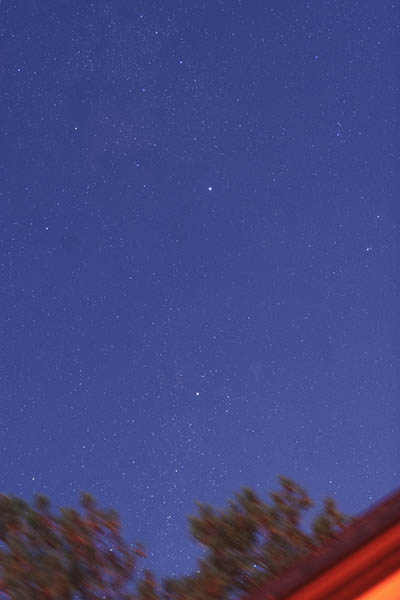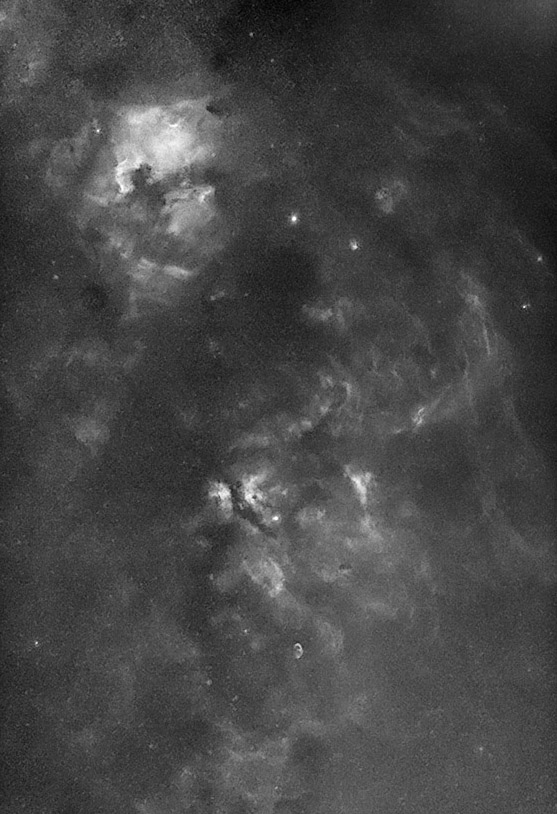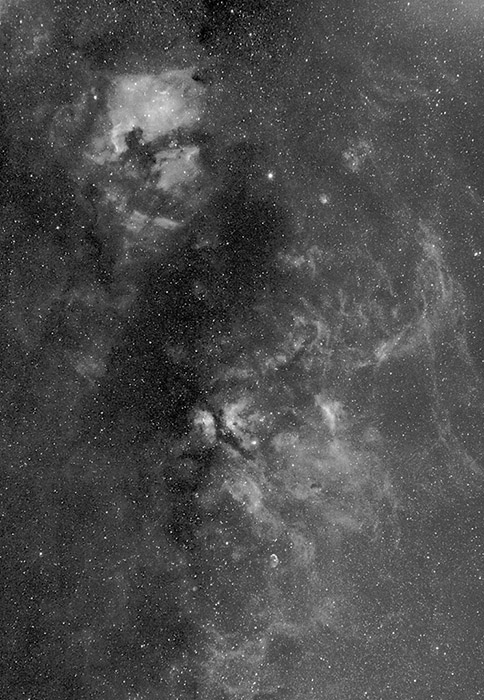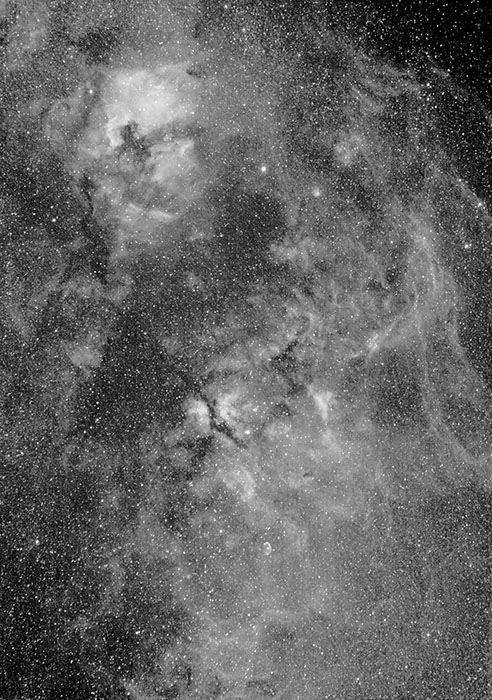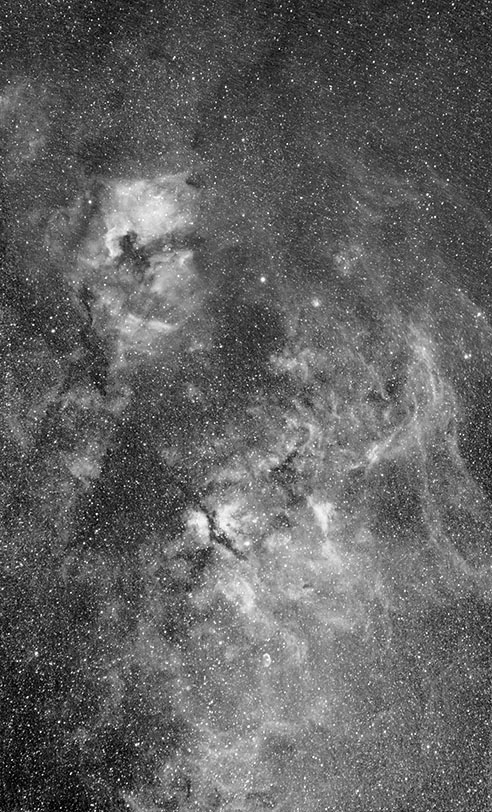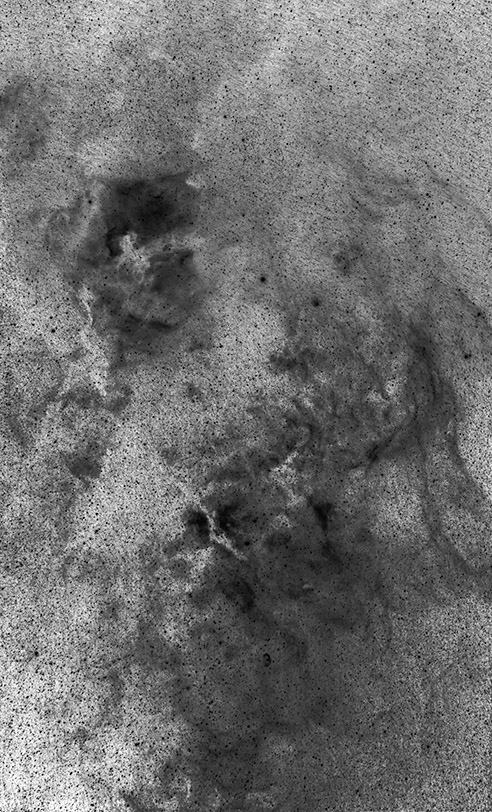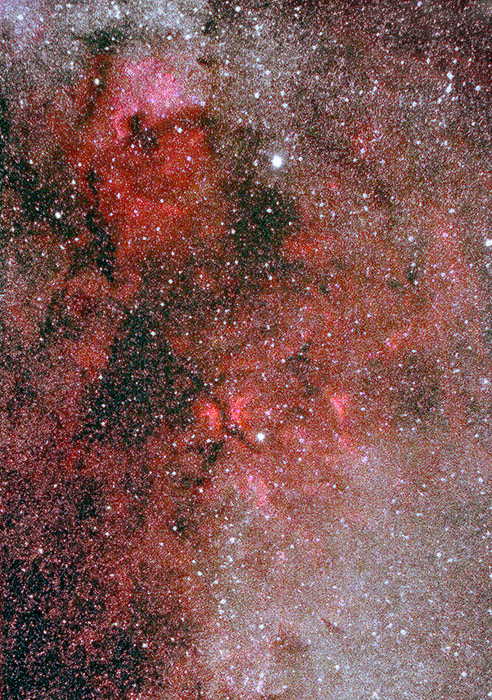|
|
Two thousand seconds (11/05/2009): that's how long the shutter was open to get the photograph above. It was shot under a brilliant, almost-full Moon. On a dewy night when I could barely see two hundred stars from one horizon to the other, this thirty-three minute exposure shows nebulae in a rich, 14-degree wide swath of the northern constellation Cygnus. On the best nights, in the best locations, using excellent optics, I've glimpsed the brightest portion of this field (the aptly-named North America Nebula). All the rest is unbelievably faint. I used a Canon 70-200mm F4L lens, dialed to near 100mm (EXIF reports 98mm), and stopped down to F5.0 on a Canon 20D modified by Hap Griffin to respond to deep red light. A Losmandy G11 mount, unguided, kept the camera aimed while it made four consecutive 500 second exposures. I aligned and averaged the individual exposures using the freeware DeepSky Stacker. I used a Baader 7nm hydrogen-alpha filter, 48mm in diameter with a clear aperture of 45mm, on the front of the lens. The front element of this lens has a diameter of 67mm so the reduced aperture cuts the light by about one stop. The lens was set at F5, but it was really working at F7. The first exposure was relatively dew-free, but by the time the fourth exposure ended, dew blocked a significant amount of light. Still, there was usable signal in it, and the extra data helped smooth the final result. I'll try this again soon and try for hours of exposure.
The 7nm hydrogen-alpha filter admits light of a particular, deep red color, the color emitted by the single electron of hydrogen when it falls from the third to the second available orbit around the single proton that is the nucleus of the hydrogen atom. The filter lets in photons having wavelengths wthin 35 Angstroms to either side of 6568A, the wavelength of the photon emitted by the hydrogen-alpha transition. That 70-Angstrom-wide window in the visual spectrum amounts to about 2% of the range between deep violet (3800A) and deep red (7500A) which humans can see. If the visible spectrum were laid out from goal line to goal line on a 100 yard football field, the Baader filter would admit light from a strip extending only about one yard on either side of the 22 yard line. Streetlights do not emit light of this wavelength, so the sky is never polluted when viewed in hydrogen-alpha light. The full Moon glows with the trivial light of a 2%-illuminated crescent. And so, on a moonlit night under the glowing dome of a nearby city, I could still open the shutter for thousands of seconds and record this panorama of faint nebulae in Cygnus. Not bad, but there's much better to come. I had trouble using a 12v adapter to hold the shutter open, but I was encouraged by the performance of a freshly charged battery. I've ordered a battery grip for the 20D from a company in China (Link Delight) along with a knockoff of the Canon timer I use for this sort of thing. The battery grip permits me to use two Canon batteries to double the long-exposure ability of the camera. The battery grip I picked (they offer a few) is an inexpensive, rudimentary model that does little besides hold batteries. It does include a tray for AA batteries; this I intend to modify to let me connect an external pack of D-cells (6 rechargeable cells would be 7.2v and up to 10,000 mAh; the camera needs 400mA to hold the shutter open, so this could provide up to 25 hours of exposure time). Then we will see what long exposures can do. The timer will let me deploy two cameras at once or serve as a backup in case this critical accessory gets damaged. More when I know more.
November 05. The next night, I tried for more light across a wider field. 70mm rather than 98mm focal length. I set the lens at F4.5 rather than F5, the camera to ISO 1600 rather than 800. The usual comedy of errors ensued (punch line: battery went dead), and again I failed to get "hours" of data, or any clean data when my subject was nearly overhead. I manged to collect another 33 minutes (2000 seconds) after Cygnus fell down from the zenith and after the Moon rose. Maybe tomorrow. Please. Here's the field in white light: 100 seconds, blue sky from moonlight, red undershot trees from Halloween lights:
And here's the same field in hydrogen-alpha, 2000 seconds:
I want at least 4x this much data to see if I can get better, cleaner "shadow" detail. Even so, you begin to see why the area between Deneb and Sadr is described as "the Northern Coal Sack" although I am here to tell you it is nowhere near as striking as the real Coal Sack in the southern sky. You also see (in the small, dark ellipse well below the North America Nebula and a little to the left) why I need to clean the sensor or shoot flats (or both).
November 6. I'm continuing to fight (and lose) battles about batteries. Two or three consecutive frames is all I seem able to get tonight. I finally plugged up the AC adapter and resigned myself to rethinking DC power later. I combined the best data from the last few nights into a 6,000 second exposure. Instead of using DeepSkyStacker, I used MaximDL. The aggregating algorithm I've been using in the former de-emphasizes stars in favor of nebulosity. I had MaximDL extract just the red plane from the Bayer matrix and worked wtih that (afterall, with the narrow Baader filter, blue and green pixels can only contribute noise). The algorithm does not favor nebulae over stars, so the field is a good bit more sparkly. Also less subtle and more garish. I need more practice, but each approach has its virtues. First, six thousand seconds of H-a, with stars:
(Click to enlarge)
These images are getting there, but they're still not everything I want from this project. Let's leave it at "Promising..." and hope for more clear weather. November 7: Another clear night, another series of exposures, this time without comic relief. AC power for the Canon, Amy's hair dryer to keep dew off the filter, and just a little shop work to tweak the mounting arrangement for the 70-200mm lens produced a very good series of images. 1600 ISO, F4.5, focussed with the 50D sans filter, then exposed with the Hap Griffin modified 20D. This is what the dust or molecular cloud that comprises the Great Rift in Cygnus looks like against its backdrop of faint but luminous hydrogen and stars:
Click to enlarge. (It's 750kb well spent.) This is 16,500 seconds (4h 35m) of exposure in hydrogen-alpha with a flat field applied to remove instrumental artifacts. Aligning 33 five-hundred-second subframes produced some striations in the sky "backgrond" which may be apparent when viewing the full-resolution image (a dark frame might reduce that substantially [it does! see below]). The Canon CR2 files were first reduced to their red Bayer planes, aligned, calibrated and then combined in MaximDL 5 with a sigma clipping algorithm (default values) to try to minimize noise in the absence of a dark frame. I saved the result as a 16 bit file and brought it into Photoshop where I adjusted the transfer function with levels and curves to retain detail in the bright bits while showing the shape of the rift. As near as I can tell, and for what it's worth in this narrow spectral window, the limiting stellar magnitude is around 12 or a few fractions fainter. (Somewhere on this page, I need to post kudos to Scott Losmandy for my ever-faithful G11, now in it's 17th year of steady tracking.) November 8: I woke up knowing there was more in that frame than I had teased out and that the limiting factor was my agility with Maxim. So I made a concerted effort to learn to make better use of its calibration tools. Then I went to work with the flat field I shot a couple of nights ago and the darks I shot late last night. Here's the same pile of data after applying darks and flats:
Click the Image to see it at full-resolution
In the beginning, I was trying to get the gear to work and aiming into an interesting part of the sky. Then I wanted to image the dark cloud that is the Great Rift, and now I am finding details I never expected: look at that "rope" of dark material extending from "Central Amerca" and running across the rift to become the dark divide in the bright nebula near Sadr and then kinking back to the north. The dark upper right corner of the frame may be the result of amplifier noise in the 20D being (over)compensated by dark frames. I'll shoot enough data with that region clear of amp glow the next clear night (tonight?) to see what's there. Stay tuned. Another clear night! And yes: there was interesting stuff hidden in the amplifier glow. I rotated the camera about 180 degrees and aimed a little farther north tonight. I exposed another 15 frames (7,500 seconds) at F4.5, ISO 1600, and patched the new data into the old frame:
Click the image for full-rez.
There's a lot of common ground in this frame and in the previous one. I should have simply repointed the camera without rotating it to make combining data across and within the two images easy. It's tempting to extend the Rift area's exposure to 24,000 seconds. Realigning tonight's data to make that possible should be straightforward. But not tonight. Since the days of Kodak plates, it's been common knowledge that low-contrast astronomical details are more readily apparent when presented as black on white rather than white on black; i.e., if you want to see faint wisps, look at the negative:
Finally (?), I used the best, latest H-a data to replace the red channel of a 100 second white light exposure, with pretty fair results. There's still something odd going on when making this substitution, but it's a good start:
Click the image for a high-res version.
November 9. Clouds at last. This is my chance to collect some thoughts from these adventures. First, a tip on using the 20D for long-exposure, automated sequences: if there is any danger of the battery failing during the sequence, set the interval between exposures to several seconds (ten, not two). This way each frame is written to the card seconds after each is finished. If the interval is too short, then the next exposure starts before the previous image is written from the buffer to the card. No harm done, right? But when exactly is the buffer written to the card under these circumstances? I lost several frames owing to batteries becoming exhausted; I thought at worst I would lose only the final frame. Not so. This is particularly troublesome when shooting startrails because then it's important to keep the intervals between exposures as short as possible. So use the best power available. Speaking of which: the 12v, 1.5w solar panel is too small to charge a 7AH battery in reasonable time. I should've done the math better and sooner. In practice, a series of sunny days raised the state of charge from 10.8 to 10.9 to 11.0 to 11.1 volts. One tenth of a volt per day will not do it for routine use. Better to discover this here than when trying to do fieldwork somewhere near the western continental divide. If you don't want a gasoline powered telescope, you'll need a bigger panel. I followed some reasonable advice I read somewhere (in the instructions that came with the panels? surely not) and "caulked" the junction between the plastic frame and the glass cover of the panel with clear silicon adhesive / sealant. Since it's marketed as something that will live on your dashboard, not in a pasture, this seems a reasonable bit of weatherproofing. November 10. I'm using the clouds and rain brought by tropical storm Ida to prepare the vintage, manual focus 200mm F2.0 EDIF Nikkor for the next clear spell. I have no H-a filter to use with this lens (though I have ideas), so I won't be bucking moonlight with it. Compared to the lens used for the photos above, it should collect ten times as many photons per unit time. This is what the elaborate camera mount showin way above is really all about; that's not needed for a lightweight like the 70-200mm F4 zoom. The Nikkor is massive. This should be interesting.
|
:: top ::
© 2010, David Cortner


